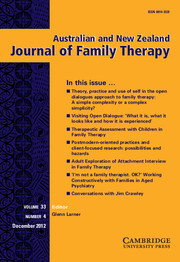Article contents
Balancing Hope and Hopelessness in Family Therapy for People Affected by Cancer
Published online by Cambridge University Press: 02 March 2012
Abstract
This paper discusses how the concepts of hope and hopelessness can affect therapeutic interventions when working with people affected by cancer. The concepts of hope and hopelessness are considered within the therapeutic relationship and the biomedical model. This explores whether there is a difference between hope and denial and considers how culture, religion, and spirituality influence an individual's interpretation of hope. For some people living with a cancer diagnosis, the word ‘hope’ can become a burden. They can feel a pressure to present as strong, positive, and hopeful in the face of extremely confronting situations. Therapists need to give patients time and space to explore their feelings of hopelessness without rushing them to a place of hope for which they are not ready. Case examples are provided and the author reflects upon her own family therapy practice working in an acute health care facility. This stresses the importance of critical reflection, supervision, and peer support.
- Type
- Articles
- Information
- Australian and New Zealand Journal of Family Therapy , Volume 32 , Issue 4 , December 2011 , pp. 329 - 342
- Copyright
- Copyright © Cambridge University Press 2011
References
- 5
- Cited by




